NCERT TEXT BOOK EXERCISES
Q1. Suppose you are in a dark room. Can you see objects in the room? Can you see objects outside the room? Explain.
Ans. We see only that objects from which reflected rays enter in our eyes. When we are in a dark room then we do not see objects. We can see objects outside the room because out of the room the light is available and that rays of light enter in our eyes after reflection.
Q2. Differentiate between regular and diffused reflection. Does diffused reflection mean the failure of the law of reflection?
Ans. Difference between regular and diffused reflection:
|
Regular Reflection |
Diffused Reflection |
| 1. It takes place on a smooth and shiny surfaces. | 1. It takes places on rough surface. |
| 2. In this case all rays are parallel after reflection. | 2. Reflected are in different direction. |
Diffused reflection is not due to the failure of the laws of reflection. It is caused by the irregularities in the reflecting surface.
Q3. Mention against each of the following whether regular or diffused reflection will take place when a beam of light strikes. Justify your answer in each case.
(a) Polished wooden table
(b) Chalk powder
(c) Card board surface
(d) Marble floor with water spread over it.
(e) Mirror
(f) Piece of paper.
Ans. (a) Polished wooden table will take place a regular reflection because its surface is smooth.
(b) Chalk, powder takes place a diffused reflection because its surface is uneven.
(c) Card board surface has minute irregularities on it, so it will have a irregular reflection.
(d) Marble floor with water spread over it takes place a regular reflection as it will act like a plane surface.
(e) Mirror has a regular reflection. It surface is also shiny and has smooth surface.
(f) Piece of a paper takes irregular of diffused reflection because it has uneven surface.
Q4. State the laws of reflection.
Ans. There are two laws of reflection.
(i) Angle of incidence is always equal to the angle of reflection.
i.e., ∠i = ∠r b
(ii) The incident ray, the normal at the point of incidence and the reflected ray all lie in the same plane.
Q5. Describe an activity to show that the incident ray, the reflected ray and the normal at the point of incidence lie in the same plane.

Ans. For this determination take a plane mirror and stand it on a plane sheet of paper with a block. Now draw an incidence line AB.Now see in the mirror and mark the points on the paper, where you fill the line is travelling after getting reflected from the mirror. Remove the mirror and draw a perpendicular on the mirror line. Join the points to make the reflected ray. You will see that incidence ray, reflected ray and normal will be in the same plane, i.e. on the sheet of paper.
Q6. Fill in the blanks in the following:
(a) A person 1 m in front of a plane mirror seems to be ………………… m away from his image
(b) If you touch your ………………… ear with right hand in front of a plane mirror it will be seen in the mirror that your right ear is touched with.
(c) The size of the pupil becomes ………………… when you see in dim light.
(d) Night birds have ………………… cones than rods in their eyes.
Ans.(a) 2
(b) left, left hand
(c) large
(d) lesser
Choose the correct option in Questions 7 – 8:
Q7. Angle of incidence is equal to the angle of reflection.
(a) Always
(b) Sometimes
(c) Under special condition
(d) Never.
Ans. (a) Always
Q8. Image formed by a plane mirror is:
(a) virtual, behind the mirror and enlarged.
(b) virtual, behind the mirror and of the same size as the object.
(c) real at the surface of the mirror and enlarged.
(d) real, behind the mirror and of the same size as the object.
Ans. (b) Virtual, behind the mirror and of the same size as the object.
Q9. Describe the construction of a kaleidoscope.
Ans. Kaleidoscope is made up of three rectangular mirror strips each about 15 cm long and 4 cm wide. Join them together to form a prisom. Fix them in circular cardboard tube. Make sure that the tube is slightly longer than the mirror strips. Close one end of the tube by a cardboard disc having a hole in the centre. To make the disc durable, paste a piece of transparent plastic sheet under the cardboard disc. At the other end, touching the mirrors, fix a circular plane glass plate.
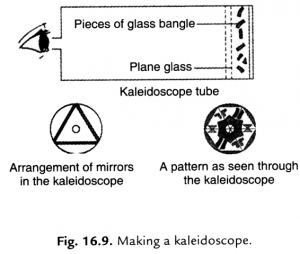
Q10. Draw a labelled sketch of the human eye.
Ans. 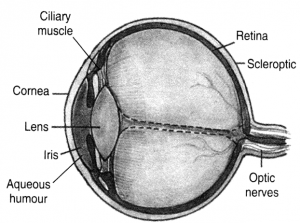
Q11. Gurmit wanted to perform activity 16.8 using a laser torch. Her teacher advised her to not to do so. Can you explain the basis of the teacher’s advise?
Ans. Laser light is harmful for eye and cause a permanent defect in the eye. She can lost her eyesight also.
Q12. Explain how you can take care of your eyes.
Ans. Following cares are required for our eyes:
(i) Do not read in too little or too much light.
(ii) Wash our eyes with cold water at least three times.
(iii) Do not look at the sun or powerful light directly.
(iv) Always read at the normal distance for vision.
(v) Do not rub our eyes with dirty hand.
Q13. What is the angle of incidence of a ray if the reflected ray is at an angle of 90° to the incidence ray?
Ans. The angle of incidence ray will be .
Q14. How many images of a candle will be formed if it is placed between two parallel mirrors separated by 40 cm?
Ans. Infinite number of images will be formed.
Q15. Two mirrors meet at right angles. A ray of light is incident on one at an angle of as shown in Fig. 16.10. Draw the reflected ray from the second mirror.
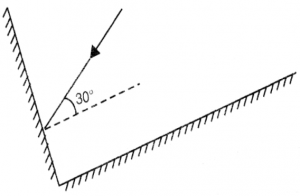
Ans. 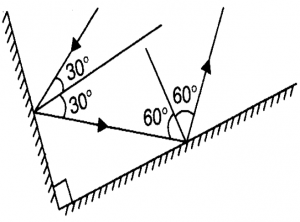
Q16. Boojho stands at A just on the side of a plane mirror as shown in Fig. 16.11. Can he see himself in the mirror? Also can he see the image of objects situated at P, Q and R?
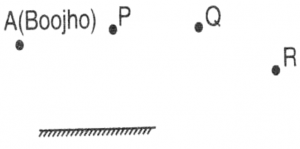
Ans. He cannot see his image himself. He can see only the image of P but not Q and R.
Q17. (a) Find out the position of the image of an object situated at A in the plane mirror (Fig. 16.12).
(b) Can Paheli at B see the image?
(c) Can Boojho at C see this image?
(d) When Paheli moves from B to C, where does the image of A move?
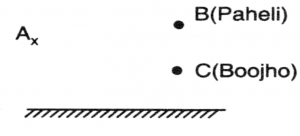
Ans. (a) 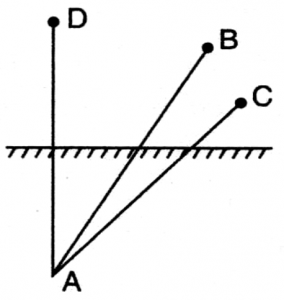
(b) Yes, Paheli can see the image at B.
(c) Yes, Boojho can see the image.
(d) No change of image A.








